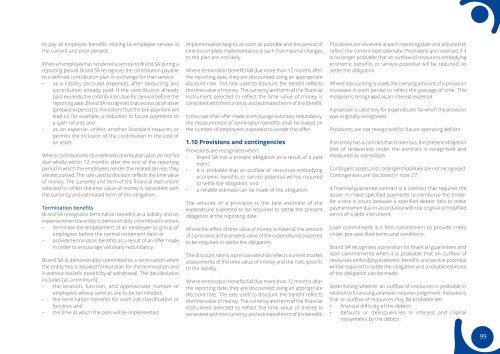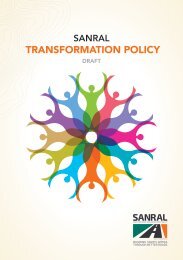Brand-South Africa - Annual report 2015 - 2016
During the past financial year, aligned with its mandate to build pride and patriotism in the Nation Brand, Brand South Africa has worked on initiatives to encourage active citizenship in partnership with its stakeholders in government, business, civil society and identified influential forums to increase the participation of all people, particularly our young people, in building a strong, cohesive Nation Brand. These activities, together with engagements at provincial level on Nation Brand alignment, contribute to social cohesion and a positive Nation Brand. Brand South Africa’s activities took place under the leadership of its new CEO, Amb. Kingsley Makhubela, PhD, who joined the organisation during the year.
During the past financial year, aligned with its mandate to build pride and patriotism in the Nation Brand, Brand South Africa has worked on initiatives to encourage active citizenship in partnership with its stakeholders in government, business, civil society and identified influential forums to increase the participation of all people, particularly our young people, in building a strong, cohesive Nation Brand. These activities, together with engagements at provincial level on Nation Brand alignment, contribute to social cohesion and a positive Nation Brand.
Brand South Africa’s activities took place under the leadership of its new CEO, Amb. Kingsley Makhubela, PhD, who joined the organisation during the year.
Create successful ePaper yourself
Turn your PDF publications into a flip-book with our unique Google optimized e-Paper software.
to pay all employee benefits relating to employee service in<br />
the current and prior periods.<br />
When an employee has rendered a service to <strong>Brand</strong> SA during a<br />
<strong>report</strong>ing period, <strong>Brand</strong> SA recognises the contribution payable<br />
to a defined contribution plan in exchange for that service:<br />
• as a liability (accrued expense), after deducting any<br />
contribution already paid. If the contribution already<br />
paid exceeds the contribution due for service before the<br />
<strong>report</strong>ing date, <strong>Brand</strong> SA recognises that excess as an asset<br />
(prepaid expense) to the extent that the pre-payment will<br />
lead to, for example, a reduction in future payments or<br />
a cash refund; and<br />
• as an expense, unless another Standard requires or<br />
permits the inclusion of the contribution in the cost of<br />
an asset.<br />
Where contributions to a defined contribution plan do not fall<br />
due wholly within 12 months after the end of the <strong>report</strong>ing<br />
period in which the employees render the related service, they<br />
are discounted. The rate used to discount reflects the time value<br />
of money. The currency and term of the financial instrument<br />
selected to reflect the time value of money is consistent with<br />
the currency and estimated term of the obligation.<br />
Termination benefits<br />
<strong>Brand</strong> SA recognises termination benefits as a liability and an<br />
expense when the entity is demonstrably committed to either:<br />
• terminate the employment of an employee or group of<br />
employees before the normal retirement date; or<br />
• provide termination benefits as a result of an offer made<br />
in order to encourage voluntary redundancy.<br />
<strong>Brand</strong> SA is demonstrably committed to a termination when<br />
the entity has a detailed formal plan for the termination and<br />
is without realistic possibility of withdrawal. The detailed plan<br />
includes [as a minimum]:<br />
• the location, function, and approximate number of<br />
employees whose services are to be terminated;<br />
• the termination benefits for each job classification or<br />
function; and<br />
• the time at which the plan will be implemented.<br />
Implementation begins as soon as possible and the period of<br />
time to complete implementation is such that material changes<br />
to the plan are not likely.<br />
Where termination benefits fall due more than 12 months after<br />
the <strong>report</strong>ing date, they are discounted using an appropriate<br />
discount rate. The rate used to discount the benefit reflects<br />
the time value of money. The currency and term of the financial<br />
instrument selected to reflect the time value of money is<br />
consistent with the currency and estimated term of the benefit.<br />
In the case of an offer made to encourage voluntary redundancy,<br />
the measurement of termination benefits shall be based on<br />
the number of employees expected to accept the offer.<br />
1.10 Provisions and contingencies<br />
Provisions are recognised when:<br />
• <strong>Brand</strong> SA has a present obligation as a result of a past<br />
event;<br />
• it is probable that an outflow of resources embodying<br />
economic benefits or service potential will be required<br />
to settle the obligation; and<br />
• a reliable estimate can be made of the obligation.<br />
The amount of a provision is the best estimate of the<br />
expenditure expected to be required to settle the present<br />
obligation at the <strong>report</strong>ing date.<br />
Where the effect of time value of money is material, the amount<br />
of a provision is the present value of the expenditures expected<br />
to be required to settle the obligation.<br />
The discount rate is a pre-tax rate that reflects current market<br />
assessments of the time value of money and the risks specific<br />
to the liability.<br />
Where termination benefits fall due more than 12 months after<br />
the <strong>report</strong>ing date, they are discounted using an appropriate<br />
discount rate. The rate used to discount the benefit reflects<br />
the time value of money. The currency and term of the financial<br />
instrument selected to reflect the time value of money is<br />
consistent with the currency and estimated term of the benefit.<br />
Provisions are reviewed at each <strong>report</strong>ing date and adjusted to<br />
reflect the current best estimate. Provisions are reversed if it<br />
is no longer probable that an outflow of resources embodying<br />
economic benefits or service potential will be required, to<br />
settle the obligation.<br />
Where discounting is used, the carrying amount of a provision<br />
increases in each period to reflect the passage of time. This<br />
increase is recognised as an interest expense.<br />
A provision is used only for expenditures for which the provision<br />
was originally recognised.<br />
Provisions are not recognised for future operating deficits.<br />
If an entity has a contract that is onerous, the present obligation<br />
(net of recoveries) under the contract is recognised and<br />
measured as a provision.<br />
Contingent assets and contingent liabilities are not recognised.<br />
Contingencies are disclosed in note 27.<br />
A financial guarantee contract is a contract that requires the<br />
issuer to make specified payments to reimburse the holder<br />
for a loss it incurs because a specified debtor fails to make<br />
payment when due in accordance with the original or modified<br />
terms of a debt instrument.<br />
Loan commitment is a firm commitment to provide credit<br />
under pre-specified terms and conditions.<br />
<strong>Brand</strong> SA recognises a provision for financial guarantees and<br />
loan commitments when it is probable that an outflow of<br />
resources embodying economic benefits and service potential<br />
will be required to settle the obligation and a reliable estimate<br />
of the obligation can be made.<br />
Determining whether an outflow of resources is probable in<br />
relation to financial guarantees requires judgement. Indications<br />
that an outflow of resources may be probable are:<br />
• financial difficulty of the debtor;<br />
• defaults or delinquencies in interest and capital<br />
repayments by the debtor;<br />
99











